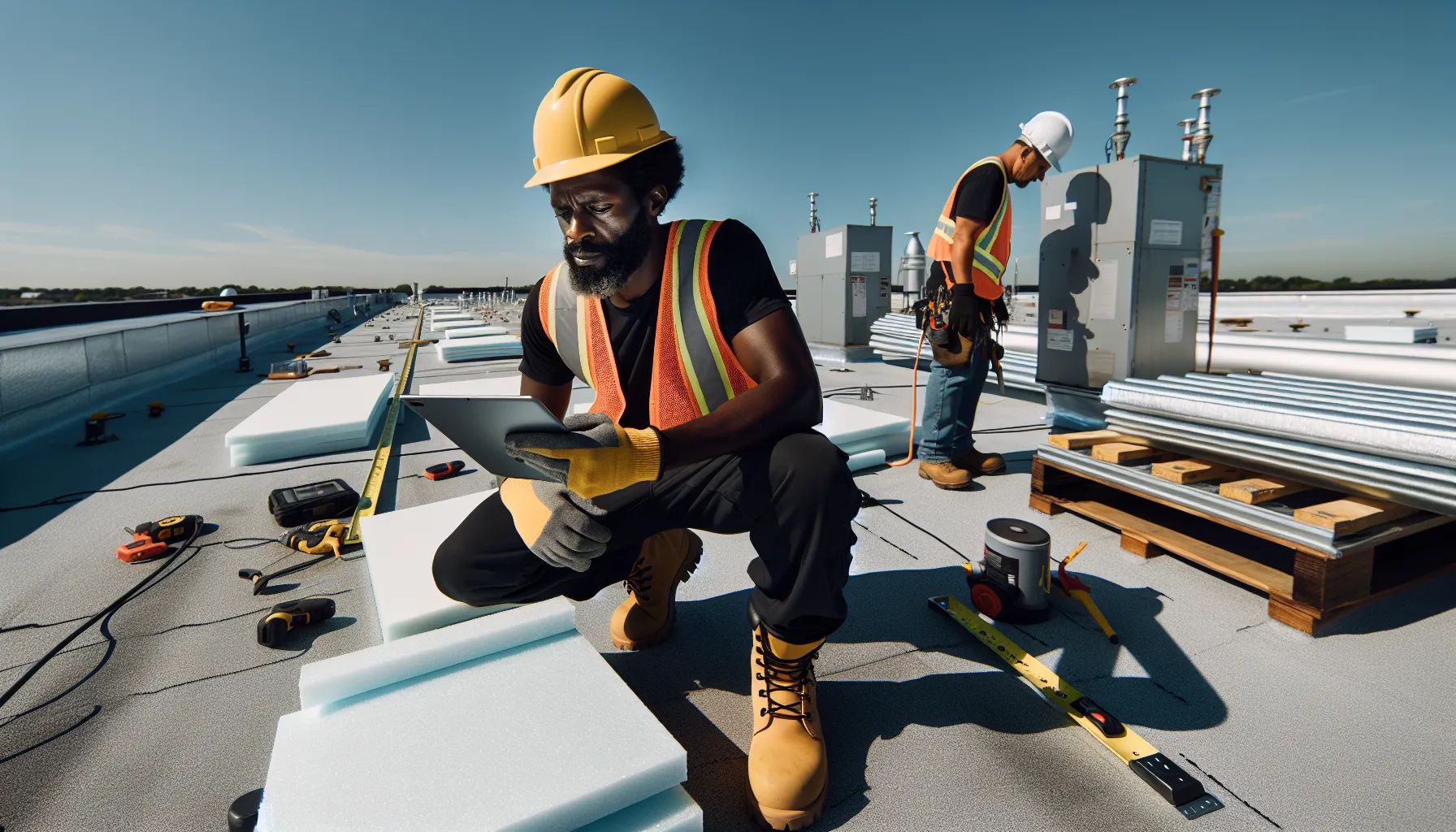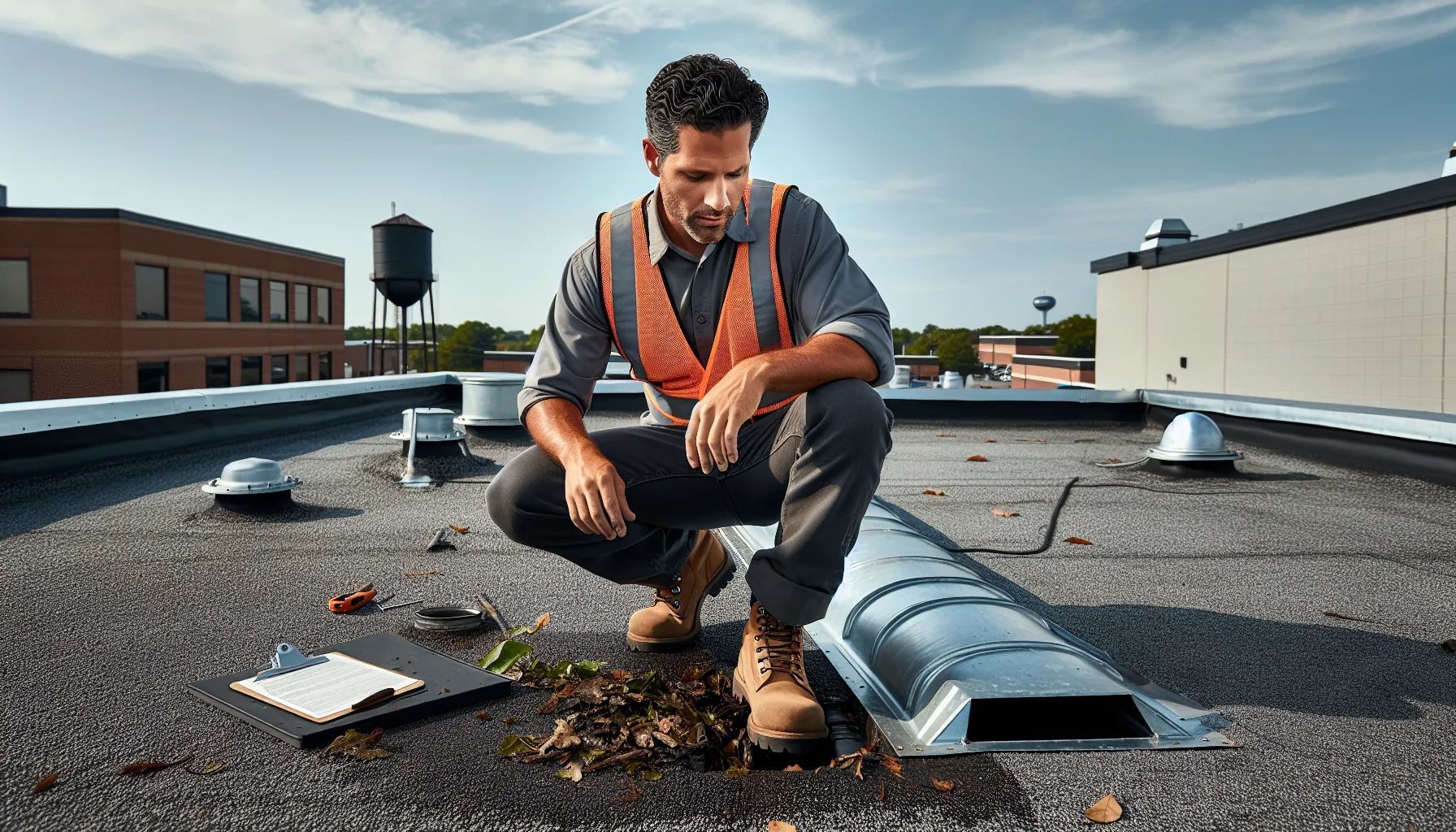Industrial Roof Leak Repair: Expert Solutions to Protect Your Facility
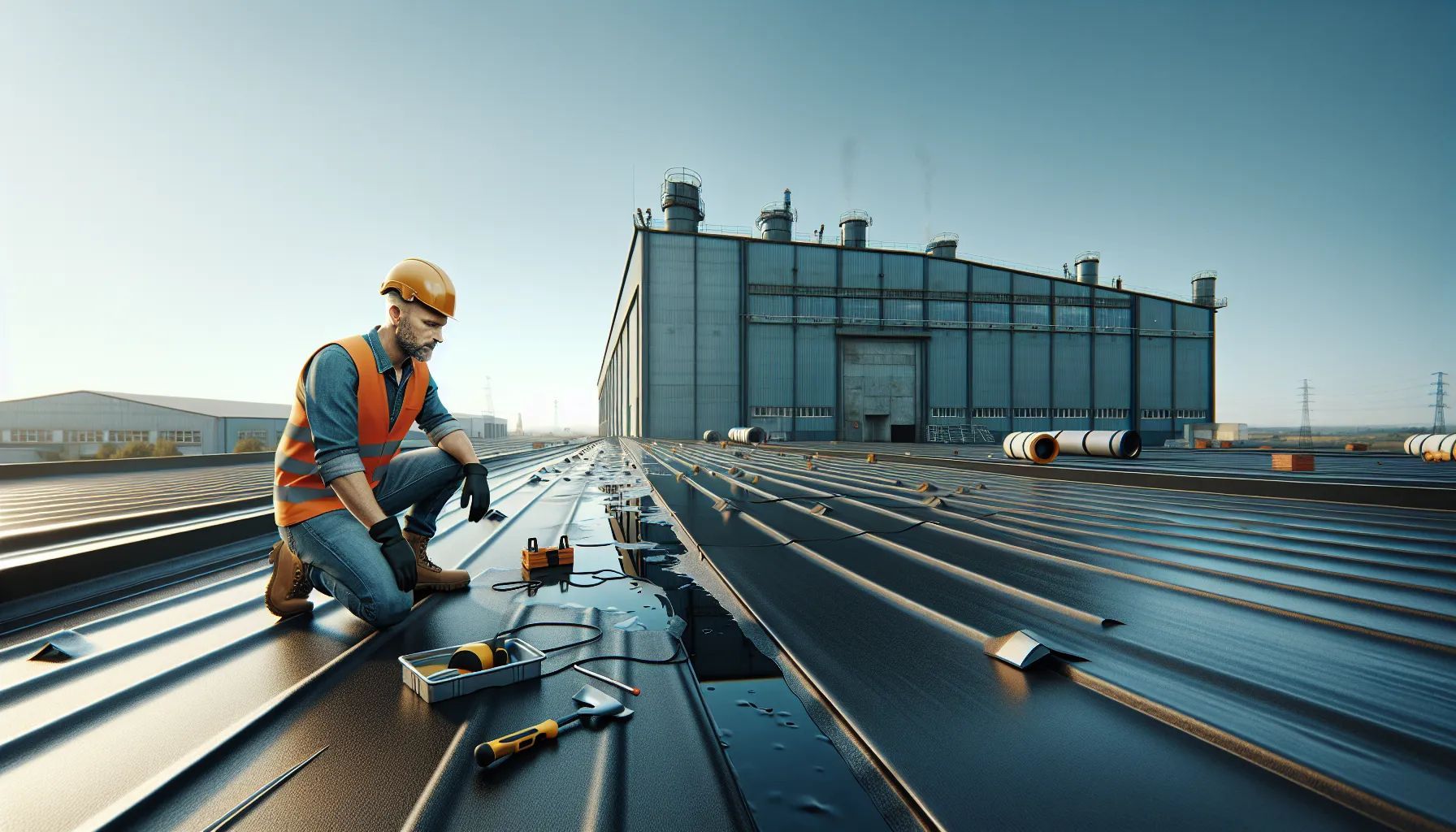
Industrial roof leak repair presents unique challenges that can't be solved with standard residential methods. We've seen firsthand how even minor leaks can escalate into major structural damage and costly production delays when left unchecked.
Managing a commercial facility means protecting valuable equipment and inventory from water damage. Yet many facility managers underestimate the complexity of industrial roofing systems until they're dealing with active leaks. The stakes are higher when you're responsible for thousands of square feet of roofing that shields critical operations.
We'll explore the most effective strategies for identifying and addressing industrial roof leaks before they compromise your facility. From understanding the warning signs to implementing long-term solutions you'll discover why specialized expertise matters in commercial roof repair.
Common Causes of Industrial Roof Leaks
Industrial roof leaks stem from multiple factors that facility managers encounter regularly. We've identified the primary culprits behind commercial roofing failures that lead to expensive repairs and operational disruptions.
Age and Weathering
Roofing materials deteriorate after 15-20 years of exposure to environmental elements. UV radiation breaks down membrane surfaces at a rate of 1-2 mils per year on EPDM and TPO systems. Temperature fluctuations cause expansion and contraction cycles that create stress cracks in roofing materials.
Industrial facilities experience accelerated weathering due to chemical emissions and extreme temperature variations. Metal roofs develop rust spots after 10-12 years without proper coating maintenance. Sealants around penetrations lose elasticity and crack after 5-7 years of weather exposure.
We observe significant degradation in roofing systems exposed to industrial pollutants and acid rain. Ponding water accelerates material breakdown by 40% compared to properly draining surfaces. Regular inspections reveal weathering damage before leaks develop into major structural problems.
Poor Installation and Workmanship
Incorrect installation accounts for 48% of premature industrial roof failures according to roofing industry data. Improper lap sealing creates pathways for water infiltration within 2-3 years of installation. Contractors who skip primer application reduce membrane adhesion strength by 60%.
Inadequate fastener patterns leave roof sections vulnerable to wind uplift during storms. We find missing edge details and improperly sealed penetrations in 35% of industrial roof inspections. Rushed installation schedules lead to shortcuts that compromise long-term roof performance.
Installation errors include incorrect membrane stretching that causes premature shrinkage and splitting. Faulty flashing installation around HVAC units and skylights creates immediate leak risks. Quality control measures during installation prevent 85% of workmanship-related failures.
Damage from Equipment and Foot Traffic
Heavy HVAC equipment causes compression damage to insulation boards beneath roofing membranes. Service technicians create punctures when dropping tools or dragging equipment across roof surfaces. We document an average of 12-15 traffic-related damages per 10,000 square feet annually on industrial roofs.
Concentrated loads from rooftop equipment exceed design specifications by 30% when improperly distributed. Regular maintenance activities generate wear patterns along common walking paths. Installation of new equipment requires careful planning to avoid compromising existing waterproofing systems.
Protection walkways reduce foot traffic damage by 90% in high-access areas. Equipment screens and designated service corridors preserve membrane integrity around mechanical units. Annual roof audits identify traffic damage before water infiltration occurs.
Signs Your Industrial Roof Needs Leak Repair
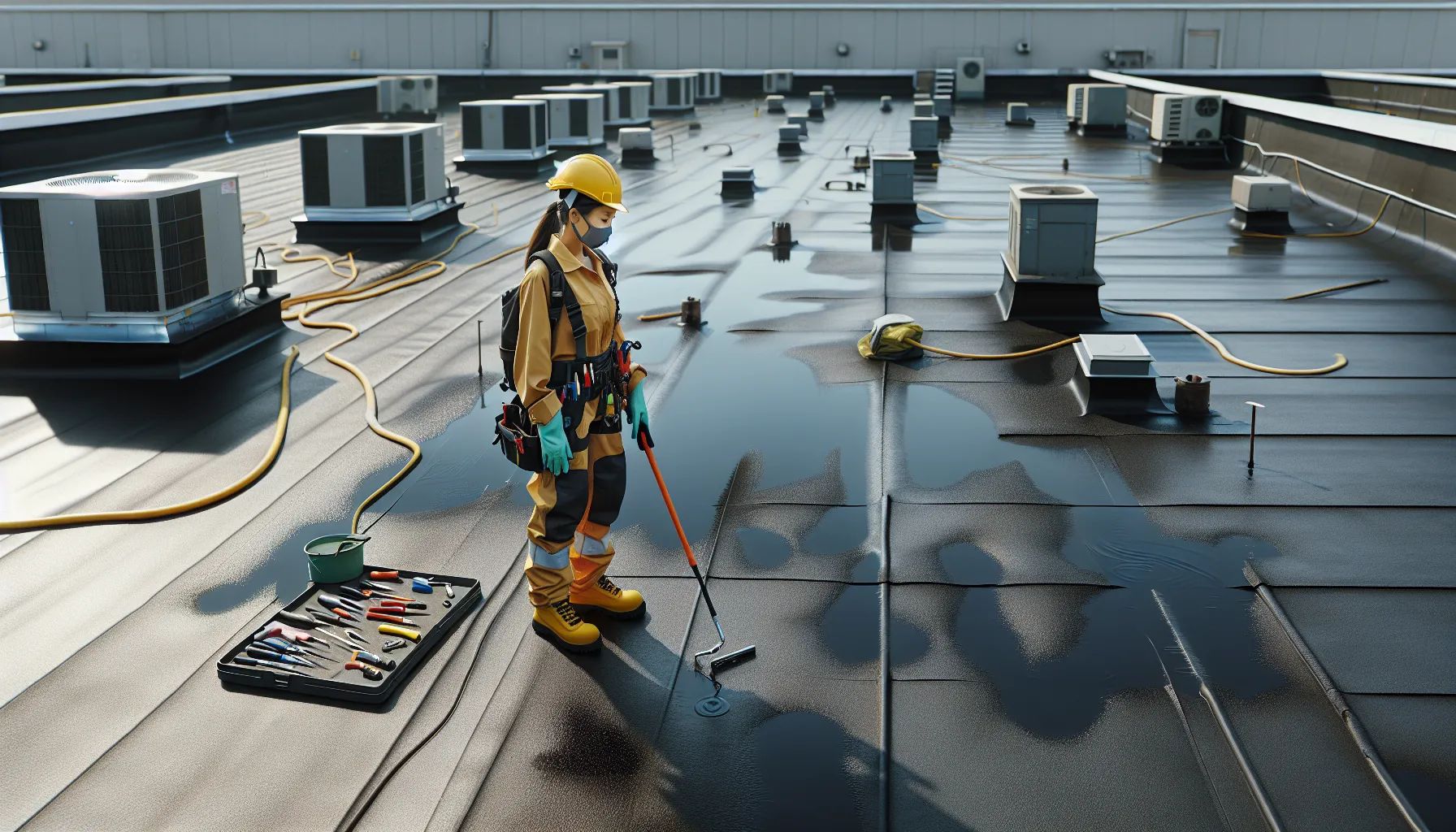
Detecting industrial roof leaks early prevents extensive damage to equipment and inventory. We identify three primary indicators that signal immediate repair requirements for commercial roofing systems.
Interior Water Stains and Drips
Water stains on ceilings and walls indicate active roof leaks requiring immediate attention. Dark circular marks appear first on ceiling tiles or drywall surfaces. These stains expand during rainstorms and often develop brown or yellow discoloration from dissolved roofing materials.
Temperature fluctuations cause stains to appear and disappear seasonally. Cold weather freezes trapped moisture while warm temperatures release accumulated water through interior surfaces. Facility managers track stain patterns to identify leak sources and determine repair urgency.
Professional inspections reveal hidden water damage behind walls and above suspended ceilings. Thermal imaging technology detects moisture concentrations invisible to standard visual checks. Early detection through regular monitoring reduces repair costs by 40-60% compared to emergency fixes after major water intrusion events.
Pooling Water and Drainage Issues
Flat industrial roofs develop standing water when drainage systems fail to remove precipitation effectively. Water pools exceed 1 inch depth after 48 hours following rainfall events on properly functioning roofs. Persistent pooling accelerates membrane deterioration and creates leak pathways within 6-12 months.
Clogged drains and scuppers cause 75% of industrial roof pooling problems. Debris accumulation includes leaves, plastic bags, and industrial dust that blocks water flow paths. Regular drain cleaning every 3-4 months maintains proper water evacuation rates.
Structural settling creates low spots where water collects on previously level surfaces. These depressions develop from foundation shifts or roof deck deterioration over 10-15 year periods. Tapered insulation systems redirect water flow toward functioning drains in affected areas.
Pooling water adds 5 pounds per square foot of load to roof structures. This weight stresses support beams and accelerates structural fatigue. Ice formation during winter months increases loads to 15-20 pounds per square foot, risking catastrophic roof collapse without timely intervention.
Visible Damage to Roofing Materials
Membrane cracks measuring 1/8 inch or wider allow water penetration into roof substrates. Single-ply membranes develop stress cracks near HVAC units and exhaust fans due to thermal cycling. Modified bitumen roofs show alligator cracking patterns across 20-30% of surface areas before major leaks occur.
Metal roof systems display rust streaks and separated seams at panel connections. Fastener backout creates 1/4 inch gaps where screws loosen from thermal expansion cycles. Standing seam roofs experience clip failure rates of 5-10% after 15 years of service without maintenance.
Flashing separations around penetrations account for 60% of industrial roof leaks. Skylights, vents, and equipment curbs develop gaps when sealants age beyond 7-10 year service lives. Pitch pockets lose fill materials through weathering and require annual topping to maintain waterproof seals.
Blisters in built-up roofing indicate moisture trapped between plies. Small blisters under 6 inches diameter multiply into widespread delamination within 2-3 years. Professional contractors remove damaged sections and install reinforced patches using compatible materials to restore waterproof integrity.
Types of Industrial Roofing Systems and Their Repair Methods
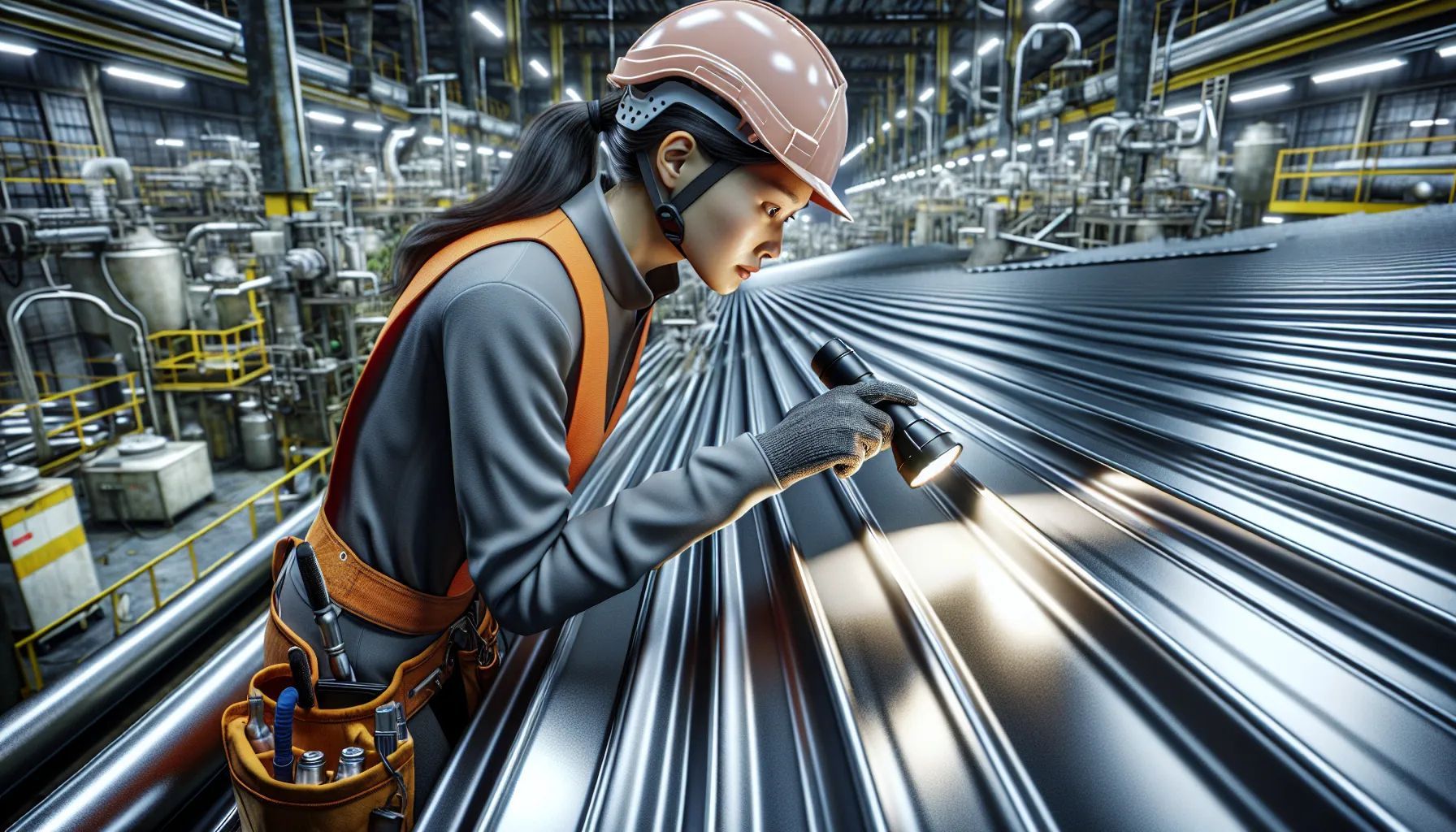
Industrial facilities use specialized roofing systems that require specific repair approaches for each material type. We've identified the most common industrial roofing systems and their corresponding repair methods to help facility managers address leaks effectively.
Metal Roof Repairs
Metal roofing systems dominate industrial facilities due to their durability and cost-effectiveness. Standing seam and corrugated metal panels protect warehouses, manufacturing plants, and distribution centers across various industries.
We start repairs by identifying the leak source through systematic inspection. Metal roofs typically leak at seams, fastener points, and flashing connections. Our repair process begins with thorough cleaning to remove rust, debris, and old sealant from affected areas.
Small leaks at seams respond well to silicone sealant application. We apply roof-compatible sealants after preparing the surface, creating a waterproof barrier that lasts 3-5 years. This temporary solution works for pinhole leaks and minor seam separations.
Larger damaged sections require metal patches or panel replacement. We cut patches from matching metal material and secure them with appropriate fasteners and sealants. Severely corroded or damaged panels need complete replacement to restore structural integrity.
Flashing repairs deserve special attention since 90% of metal roof leaks occur at flashing points. We remove deteriorated flashing, clean the substrate, and install new galvanized or aluminum flashing with proper overlap and sealant application.
Built-Up Roof (BUR) Repairs
Built-up roofing systems consist of alternating layers of bitumen and reinforcing fabric, creating a multi-ply waterproof membrane. These systems excel on flat or low-slope industrial roofs where ponding water poses challenges.
BUR repairs require careful assessment of damage depth through all layers. We cut through the membrane to expose damaged plies, removing wet or deteriorated materials down to sound substrate. The multi-layer construction makes repairs more complex than single-membrane systems.
Blisters and tears demand immediate attention to prevent water infiltration. We slice open blisters, dry the cavity, and apply hot bitumen between layers before pressing them flat. Large tears require cutting out damaged sections and installing multi-ply patches with heat-welded or cold-applied adhesives.
Minor cracks and surface damage respond to mastic application. We use modified asphalt mastics compatible with the existing BUR system, applying them in 1/8-inch layers over prepared surfaces. These repairs extend roof life by 2-3 years when properly maintained.
Extensive damage covering more than 25% of the roof surface often necessitates replacement. The layered construction makes partial replacement challenging, as new and old sections must integrate seamlessly to prevent future leaks.
Single-Ply Membrane Repairs
Single-ply membranes include EPDM (rubber), TPO (thermoplastic), and PVC materials that offer excellent weather resistance and installation efficiency. These membranes cover approximately 40% of industrial flat roofs due to their lightweight properties and chemical resistance.
Membrane repairs start with cleaning the damaged area using manufacturer-approved cleaners. We remove all contaminants, including dirt, oils, and oxidation, ensuring proper adhesion of repair materials. Clean surfaces improve patch bonding strength by 50%.
Punctures and tears smaller than 2 inches receive reinforced patches. We round patch corners to prevent peeling and extend patches 3 inches beyond damage in all directions. Heat welding creates the strongest bonds for TPO and PVC membranes, while EPDM requires specialized adhesives.
Seam failures represent the most common single-ply membrane issue. We probe seams to identify separation areas, clean both surfaces, and reactivate adhesives or perform heat welding. Proper seam repair prevents 80% of membrane leaks when caught early.
Post-repair inspection includes checking underlying insulation for moisture damage. Wet insulation loses R-value and promotes mold growth, requiring replacement before membrane repairs. We use moisture meters to map affected areas and ensure complete water damage remediation.
Professional Inspection and Assessment Process
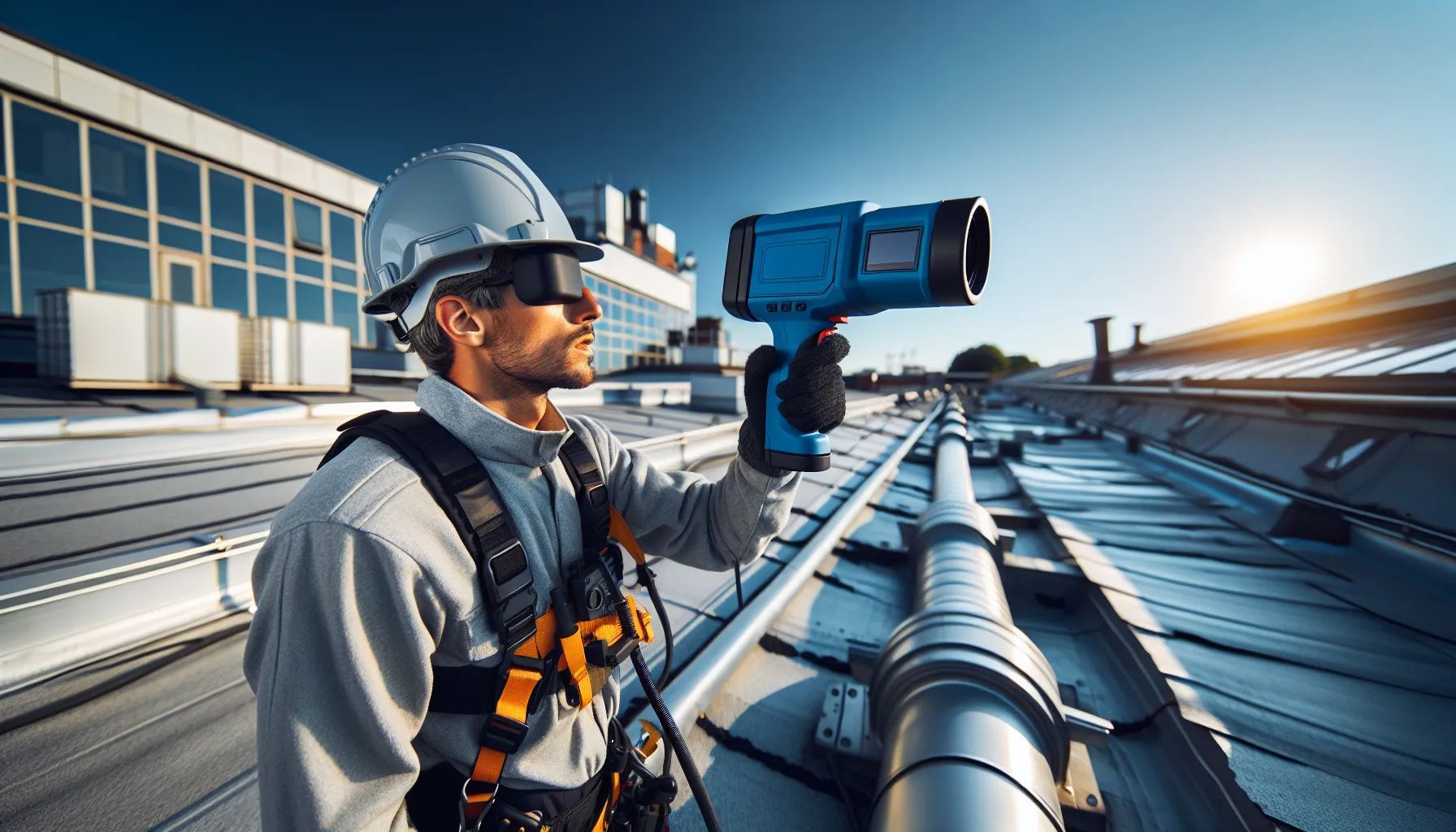
Professional inspection forms the foundation of effective industrial roof leak repair. We conduct systematic evaluations to identify damage extent and plan appropriate repair strategies that prevent future leaks.
Initial Damage Evaluation
We start our inspection process by examining both exterior and interior roof surfaces. Our technicians check for visible signs of damage including membrane tears, rust spots, and deteriorated sealants. Interior inspections reveal water stains, mold growth, and structural damage that indicate leak severity.
During exterior assessments, we document specific damage locations using grid mapping systems. Each damaged area receives a detailed description noting material type, damage size, and potential water entry points. We photograph all findings to create comprehensive repair documentation.
Our evaluation includes checking drainage systems, gutters, and downspouts for blockages. Clogged drains cause water accumulation that accelerates roof deterioration. We measure ponding water depths and mark areas exceeding manufacturer specifications.
Safety equipment inspections accompany damage evaluations. We verify that roof access points, walkways, and fall protection systems remain intact. Damaged safety features receive immediate temporary repairs to protect inspection teams and future maintenance personnel.
Moisture Detection Technology
Advanced moisture detection equipment allows us to locate hidden water infiltration. Infrared thermography cameras detect temperature variations that indicate trapped moisture beneath roofing membranes. These cameras identify wet insulation and saturated roof decking without invasive testing.
Electronic moisture meters provide precise moisture content readings in roofing materials. We use capacitance meters for non-conductive materials and resistance meters for wood decking. Readings above 19% moisture content indicate areas requiring immediate attention.
Nuclear moisture gauges offer depth-specific moisture measurements in concrete roof decks. These devices emit low-level radiation to measure hydrogen atoms in water molecules. We create moisture maps showing saturation levels throughout the roof structure.
Thermal imaging during temperature transitions reveals moisture patterns most clearly. Early morning or late evening scans show maximum temperature differentials between wet and dry areas. We combine thermal data with physical testing to confirm moisture presence and calculate affected square footage.
Cost Estimation and Repair Planning
Accurate cost estimates require detailed damage assessments and material specifications. We calculate repair costs based on damaged square footage, material prices, and labor requirements. Minor sealant applications cost $200-500 while complete roof replacements range from $5-12 per square foot.
Our repair plans prioritize critical areas affecting building operations. Active leaks above production equipment receive immediate attention. We schedule repairs to minimize business disruptions and coordinate with facility managers for optimal timing.
Material selection considers compatibility with existing roofing systems. We specify identical membrane types for patches and match metal panel profiles exactly. Using incompatible materials causes premature failure and voids manufacturer warranties.
Repair timelines account for weather conditions and material availability. Most minor repairs complete within 1-2 days while major replacements require 2-4 weeks. We provide detailed project schedules showing each repair phase and expected completion dates.
Industrial Roof Leak Repair Techniques
We employ specific repair methods to address industrial roof leaks effectively and prevent costly damage to equipment and operations. Our systematic approach combines immediate response protocols with long-term solutions designed for commercial facilities.
Emergency Temporary Fixes
We start emergency repairs by placing buckets beneath active leaks to protect equipment and inventory. Our team secures waterproof tarps over damaged areas using weighted sandbags or fasteners rated for 50+ mph winds.
We apply roofing cement to small cracks measuring less than 2 inches. The cement creates a temporary seal lasting 3-6 months under normal weather conditions. Our technicians use industrial-grade caulk for gaps around penetrations like HVAC units and skylights.
Rubber sealant works effectively on metal roof seams experiencing minor separation. We clean the affected area thoroughly before application to ensure proper adhesion. The sealant bonds within 24 hours and withstands temperature fluctuations between -20°F and 180°F.
Safety remains our priority during emergency repairs. We establish exclusion zones beneath leak areas and use proper fall protection equipment on roofs exceeding 6 feet in height. Our rapid response team arrives within 2-4 hours to minimize production disruptions and water damage.
Permanent Repair Solutions
We select industrial-grade materials compatible with existing roofing systems for permanent repairs. TPO patches match TPO membranes while EPDM adhesives bond specifically to EPDM surfaces. Metal roof repairs require color-matched panels and fasteners meeting manufacturer specifications.
Our technicians replace damaged flashing completely rather than attempting patches. New flashing installations include proper overlap dimensions (minimum 4 inches) and sealed edges using appropriate adhesives. We reinforce critical areas like parapet walls and equipment curbs with additional membrane layers.
Large hole repairs involve cutting out damaged sections and installing new material. We extend patches 6 inches beyond damage perimeters on single-ply membranes. Metal roof patches require riveted or screwed connections with butyl tape creating watertight seals.
Quality assurance protocols include water testing repaired areas after 48 hours. We document all repairs with photographs and provide detailed reports specifying materials used and warranty terms. Our permanent repairs carry 5-10 year warranties depending on repair scope and materials.
Preventive Maintenance Strategies
We schedule professional inspections twice yearly in spring and fall. These inspections identify potential problems before leaks develop. Our 21-point checklist covers drainage systems, flashing integrity, and membrane condition.
Early warning signs receive immediate attention during maintenance visits. Water stains measuring 2 square feet or larger indicate active moisture infiltration requiring investigation. We address loose fasteners, separated seams, and deteriorating sealants during routine maintenance.
Drainage system maintenance prevents 60% of industrial roof leaks. We clear debris from drains and gutters monthly during leaf season. Our teams install protective screens over drains in areas with heavy tree coverage.
We recommend high-performance coatings for roofs approaching 10 years of age. Silicone coatings extend roof life by 10-15 years when applied properly. Our maintenance programs include annual coating inspections and touch-ups maintaining manufacturer warranties.
Choosing the Right Industrial Roofing Contractor
Selecting a qualified contractor for industrial roof leak repair determines the success of your project. We'll examine the essential criteria that separate experienced professionals from inadequate service providers.
Credentials and Experience
Industrial roofing contractors must possess proper licensing and certifications for commercial work. General liability insurance and workers' compensation coverage protect both facility owners and workers during repairs. Contractors specializing in industrial roofs understand flat, metal, and membrane systems that differ from residential installations.
Experience matters in industrial settings. Contractors who've completed 50+ commercial projects demonstrate competence with large-scale repairs. Manufacturer certifications indicate specialized training for EPDM, TPO, or modified bitumen systems. These certifications require contractors to pass technical exams and maintain quality standards.
Ask contractors for references from similar industrial facilities. Projects involving warehouses, manufacturing plants, or distribution centers showcase relevant expertise. Contractors who repair roofs on buildings exceeding 10,000 square feet understand industrial-scale challenges.
Verify the contractor holds current state licensing for commercial roofing work. Insurance certificates must show minimum coverage of $1 million for general liability. Workers' compensation documentation confirms protection for crew members working at heights.
Safety Standards and Insurance
Industrial roof repairs involve significant safety risks requiring strict protocols. Contractors must follow OSHA regulations for fall protection, including harnesses, guardrails, and safety nets for work above 6 feet. Professional contractors conduct daily safety briefings and maintain written safety programs.
Insurance verification prevents liability issues. Request certificates of insurance directly from the carrier, not photocopies. Coverage must remain active throughout the project duration. Contractors lacking proper insurance expose facility owners to lawsuits and financial losses[2].
Safety equipment includes hard hats, non-slip footwear, and high-visibility vests for all crew members. Industrial facilities often require additional safety measures like lockout/tagout procedures near electrical equipment. Contractors familiar with industrial environments understand these requirements.
Professional contractors maintain safety records documenting accident rates below industry averages. Zero-accident contractors demonstrate commitment to worker protection. Safety violations or frequent accidents indicate poor management and training practices.
Warranty and Service Agreements
Comprehensive warranties protect your investment in roof repairs. Material warranties from manufacturers typically cover 10-20 years for industrial roofing products. Workmanship warranties from contractors guarantee installation quality for 2-5 years minimum[2].
Service agreements extend roof lifespan through regular maintenance. Quarterly inspections identify minor issues before they become major leaks. Annual maintenance contracts include cleaning drains, resealing penetrations, and documenting roof conditions.
Written warranty terms specify coverage limitations and claim procedures. Exclusions might include damage from extreme weather or improper modifications. Understanding warranty details prevents disputes during future leak occurrences.
Contractors offering extended service agreements demonstrate confidence in their work quality. Maintenance programs cost 3-5% of replacement value annually but prevent 70% of premature failures. Regular service visits establish relationships that expedite emergency repairs when leaks occur unexpectedly.
Cost Factors for Industrial Roof Leak Repairs
Industrial roof leak repair costs vary significantly based on specific factors unique to commercial facilities. We'll explore the key elements that influence pricing to help you budget effectively for necessary repairs.
Repair vs. Replacement Considerations
Minor leaks with localized damage typically cost between $150 and $2,000 to repair. We find these repairs most economical when damage affects less than 25% of the roof surface. Small punctures, isolated flashing failures, and minor seam separations fall into this category.
Major leaks presenting structural damage often make replacement more cost-effective than repair. Facilities with roofs older than 20 years experiencing multiple leak points benefit from complete replacement. Widespread membrane deterioration, extensive rust on metal roofs, or saturated insulation requires replacement rather than patching.
The 50% rule guides our decision-making process. Repair costs exceeding 50% of replacement value indicate replacement as the better investment. A 10,000-square-foot metal roof costing $8,000 to repair versus $12,000 to replace clearly favors repair. The same roof requiring $7,000 in repairs suggests replacement consideration.
Professional assessments determine the most economical approach. We evaluate damage extent, roof age, and future maintenance requirements. This analysis prevents costly repeat repairs and maximizes your roofing investment.
Material and Labor Costs
Labor represents approximately 60% of total repair expenses, averaging $40 to $100 per hour. Complex repairs on steep slopes or difficult-access areas push labor costs toward the higher range. A two-person crew working eight hours at $75 per hour costs $1,200 in labor alone.
Material costs depend on roofing type and repair extent:
| Roofing Material | Cost per Square Foot | Typical Repair Range |
|---|---|---|
| Asphalt/Composite | $3-5 | $150-500 |
| Metal | $7-12 | $300-1,500 |
| TPO | $5-8 | $250-1,000 |
| EPDM | $4-7 | $200-800 |
| Built-up Roofing | $6-10 | $400-1,200 |
Specialty materials like slate or tile increase costs substantially. These materials require experienced technicians and careful handling. A 100-square-foot slate repair might cost $2,000 compared to $400 for similar-sized asphalt repairs.
Additional factors affecting costs include permit fees, equipment rental, and disposal charges. Crane rentals for accessing tall buildings add $500 to $2,000 per day. Proper disposal of old roofing materials costs $300 to $800 depending on volume.
Long-Term Value Analysis
Prompt repairs prevent cascading damage that multiplies costs exponentially. A $500 leak repair today prevents $5,000 in structural damage six months later. Water infiltration damages insulation, decking, and structural components when left unaddressed.
Quality materials with extended lifespans reduce lifetime repair frequency. Premium TPO membranes lasting 30 years cost 20% more initially but eliminate multiple repair cycles. We calculate total ownership costs over expected service life rather than focusing on upfront expenses.
Professional installation ensures repairs last their intended lifespan. Certified contractors fix leaks correctly the first time, avoiding repeat service calls. Their work typically includes warranties covering materials and labor for 5 to 10 years.
Energy efficiency improvements during repairs provide ongoing savings. Adding insulation or reflective coatings reduces heating and cooling costs by 15% to 30%. These enhancements pay for themselves within 3 to 5 years through reduced utility expenses.
Conclusion
Industrial roof leak repair demands specialized expertise and swift action to protect your facility's operations and assets. We've seen how seemingly minor leaks can escalate into major structural issues that threaten productivity and profitability.
The key to successful leak management lies in partnering with qualified commercial roofing professionals who understand the unique challenges of industrial systems. Their expertise ensures proper diagnosis and long-lasting repairs that keep your facility running smoothly.
Regular maintenance and proactive monitoring aren't just smart practices—they're essential investments in your facility's future. By staying ahead of potential issues through scheduled inspections and timely repairs we can significantly extend roof life while minimizing emergency situations.
Remember that every industrial facility has unique roofing needs based on its operations and environmental factors. What works for one building might not suit another which is why customized solutions matter.
Your roof protects everything beneath it. Make sure it's getting the professional attention it deserves to safeguard your business for years to come.
What are the most common causes of industrial roof leaks?
The three main causes are age and weathering (typically after 15-20 years), poor installation and workmanship (accounting for nearly 50% of premature failures), and damage from heavy equipment and foot traffic. Environmental factors like UV radiation and temperature changes cause materials to deteriorate, while improper sealing and faulty flashing during installation create vulnerable points for water infiltration.
How can I tell if my industrial roof needs leak repair?
Key indicators include water stains on ceilings and walls, pooling water on flat roofs, and visible damage like membrane cracks or rust streaks. Look for separated flashing, soft spots in the roofing material, and any signs of moisture inside the building. Regular professional inspections can detect hidden problems before they become major issues.
Should I repair or replace my leaking industrial roof?
Follow the "50% rule" - if repair costs exceed 50% of replacement cost, replacement is usually more economical. Minor, localized leaks are typically good candidates for repair, while extensive structural damage or multiple leak points may warrant full replacement. A professional assessment is crucial for making this decision based on your specific situation.
What emergency measures can I take for a sudden roof leak?
Install waterproof tarps over affected areas, apply roofing cement to small holes, and use rubber sealants for immediate water stoppage. Always prioritize safety by avoiding wet surfaces and electrical hazards. These are temporary fixes only - schedule professional repairs as soon as possible to prevent further damage to equipment and inventory.
How much do industrial roof leak repairs typically cost?
Costs vary widely based on roof type, damage extent, and facility size. Labor typically represents 60-70% of total repair costs. Minor repairs might cost a few thousand dollars, while major repairs can reach tens of thousands. Long-term value analysis shows prompt repairs prevent cascading damage and save money compared to deferred maintenance.
How do I choose the right contractor for industrial roof repairs?
Look for contractors with proper licensing, comprehensive insurance, and proven experience with large-scale industrial projects. Verify their safety certifications and request references from similar facilities. Ensure they offer detailed warranties and service agreements. The right contractor should provide thorough inspections, transparent pricing, and understand the unique challenges of commercial roofing systems.
